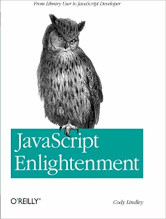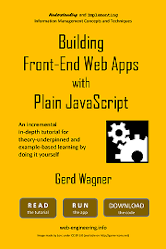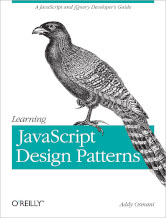Last Updated on February 14, 2025
4. JavaScript Enlightenment by Cody Lindley

JavaScript Enlightenment seeks to give an accurate JavaScript world-view through an examination of native JavaScript objects and supporting nuances: complex values, primitive values, scope, inheritance, the head object, etc.
This book offers a curated selection of the commonly used language updates After studying the material in this book grokking new JavaScript code while learning JavaScript frameworks and tools, readers should be much more comfortable.
The book solidifies your understanding of the language.
Chapters cover:
- Get a short and digestible summary of ECMA-262, Edition 3; the most widely implemented version of JavaScript to date.
- Examine the creation of JavaScript objects.
- Learn complex values, primitive values, scope, and inheritance.
- Understand the importance of the head object.
- Work with string, number, and Boolean objects and values.
- Discover how to use the null value and the built-in math object.
- Get into the details—beyond Mozilla’s reference guide for JavaScript 1.5.
The book is targeted at advanced beginners or intermediate JavaScript developers who wish to solidify their understanding of the language through an in-depth look at JavaScript objects. The book also aims to reach the JavaScript library veteran who is ready to look behind the curtain. It is not an exhaustive reference guide to JavaScript.
The first edition of the book is published under an open source license.
5. Building Front-End Web Apps with Plain JavaScript by Gerd Wagner

Building Front-End Web Apps with Plain JavaScript is an in-depth tutorial.
Chapters cover:
- Getting Started.
- More on JavaScript.
- Building a Minimal App with Plain JavaScript in Seven Steps.
- Integrity Constraints.
- Constraint Validation in a Plain JS Front-End App.
- Enumerations and Enumeration Attributes.
- Implementing Enumeration Attributes in a Plain JS App.
- Reference Properties and Unidirectional Associations.
- Implementing Unidirectional Functional Associations with Plain JavaScript.
- Implementing Unidirectional Non-Functional Associations with Plain JavaScript.
- Bidirectional Associations.
- Implementing Bidirectional Associations with Plain JavaScript.
- Part-Whole Associations.
- Subtyping and Inheritance.
- Subtyping in a Plain JavaScript Front-End App.
- The Model-Based Development Framework mODELcLASSjs.
- Constraint Validation with mODELcLASSjs.
This book, along with any associated source code, is licensed under The Code Project Open License (CPOL).
6. Learning JavaScript Design Patterns by Addy Osmani
 Design patterns are reusable solutions to commonly occurring problems in software design. They are both exciting and a fascinating topic to explore in any programming language.
Design patterns are reusable solutions to commonly occurring problems in software design. They are both exciting and a fascinating topic to explore in any programming language.
In this book we will explore applying both classical and modern design patterns to the JavaScript programming language.
This book is targeted at professional developers wishing to improve their knowledge of design patterns and how they can be applied to the JavaScript programming language.
Learning JavaScript Design Patterns is released under a Creative Commons Attribution-Noncommercial-No Derivative Works 3.0 unported license. It is available for purchase via O’Reilly Media but is both free online and as a physical (or eBook) purchase for readers.
Next page: Page 3 – Developing Backbone.js Applications and more books
Pages in this article:
Page 1 – You Don’t Know JS (book series) and more books
Page 2 – JavaScript Enlightenment and more books
Page 3 – Developing Backbone.js Applications and more books
Page 4 – jQuery Fundamentals and more books
Page 5 – JavaScript Bible and more books
Page 6 – Object-Oriented JavaScript and more books
All books in this series:
| Free Programming Books | |
|---|---|
| Ada | ALGOL-like programming language, extended from Pascal and other languages |
| Agda | Dependently typed functional language based on intuitionistic Type Theory |
| Arduino | Inexpensive, flexible, open source microcontroller platform |
| Assembly | As close to writing machine code without writing in pure hexadecimal |
| Awk | Versatile language designed for pattern scanning and processing language |
| Bash | Shell and command language; popular both as a shell and a scripting language |
| BASIC | Beginner’s All-purpose Symbolic Instruction Code |
| C | General-purpose, procedural, portable, high-level language |
| C++ | General-purpose, portable, free-form, multi-paradigm language |
| C# | Combines the power and flexibility of C++ with the simplicity of Visual Basic |
| Clojure | Dialect of the Lisp programming language |
| ClojureScript | Compiler for Clojure that targets JavaScript |
| COBOL | Common Business-Oriented Language |
| CoffeeScript | Transcompiles into JavaScript inspired by Ruby, Python and Haskell |
| Coq | Dependently typed language similar to Agda, Idris, F* and others |
| Crystal | General-purpose, concurrent, multi-paradigm, object-oriented language |
| CSS | CSS (Cascading Style Sheets) specifies a web page’s appearance |
| D | General-purpose systems programming language with a C-like syntax |
| Dart | Client-optimized language for fast apps on multiple platforms |
| Dylan | Multi-paradigm language supporting functional and object-oriented coding |
| ECMAScript | Best known as the language embedded in web browsers |
| Eiffel | Object-oriented language designed by Bertrand Meyer |
| Elixir | Relatively new functional language running on the Erlang virtual machine |
| Erlang | General-purpose, concurrent, declarative, functional language |
| F# | Uses functional, imperative, and object-oriented programming methods |
| Factor | Dynamic stack-based programming language |
| Forth | Imperative stack-based programming language |
| Fortran | The first high-level language, using the first compiler |
| Go | Compiled, statically typed programming language |
| Groovy | Powerful, optionally typed and dynamic language |
| Haskell | Standardized, general-purpose, polymorphically, statically typed language |
| HTML | HyperText Markup Language |
| Icon | Wide variety of features for processing and presenting symbolic data |
| J | Array programming language based primarily on APL |
| Java | General-purpose, concurrent, class-based, object-oriented, high-level language |
| JavaScript | Interpreted, prototype-based, scripting language |
| Julia | High-level, high-performance language for technical computing |
| Kotlin | More modern version of Java |
| LabVIEW | Designed to enable domain experts to build power systems quickly |
| LaTeX | Professional document preparation system and document markup language |
| Lisp | Unique features - excellent to study programming constructs |
| Logo | Dialect of Lisp that features interactivity, modularity, extensibility |
| Lua | Designed as an embeddable scripting language |
| Markdown | Plain text formatting syntax designed to be easy-to-read and easy-to-write |
| Objective-C | Object-oriented language that adds Smalltalk-style messaging to C |
| OCaml | The main implementation of the Caml language |
| Pascal | Imperative and procedural language designed in the late 1960s |
| Perl | High-level, general-purpose, interpreted, scripting, dynamic language |
| PHP | PHP has been at the helm of the web for many years |
| PostScript | Interpreted, stack-based and Turing complete language |
| Prolog | A general purpose, declarative, logic programming language |
| PureScript | Small strongly, statically typed language compiling to JavaScript |
| Python | General-purpose, structured, powerful language |
| QML | Hierarchical declarative language for user interface layout - JSON-like syntax |
| R | De facto standard among statisticians and data analysts |
| Racket | General-purpose, object-oriented, multi-paradigm, functional language |
| Raku | Member of the Perl family of programming languages |
| Ruby | General purpose, scripting, structured, flexible, fully object-oriented language |
| Rust | Ideal for systems, embedded, and other performance critical code |
| Scala | Modern, object-functional, multi-paradigm, Java-based language |
| Scheme | A general-purpose, functional language descended from Lisp and Algol |
| Scratch | Visual programming language designed for 8-16 year-old children |
| SQL | Access and manipulate data held in a relational database management system |
| Standard ML | General-purpose functional language characterized as "Lisp with types" |
| Swift | Powerful and intuitive general-purpose programming language |
| Tcl | Dynamic language based on concepts of Lisp, C, and Unix shells |
| TeX | Markup and programming language - create professional quality typeset text |
| TypeScript | Strict syntactical superset of JavaScript adding optional static typing |
| Vala | Object-oriented language, syntactically similar to C# |
| VHDL | Hardware description language used in electronic design automation |
| VimL | Powerful scripting language of the Vim editor |
| XML | Rules for defining semantic tags describing structure ad meaning |

sorry 8- Link ????
All the links are working